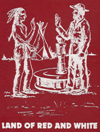 CREEK HILLS FARM
CREEK HILLS FARM
by George Kinch
I was born at Woodford, near London, England, in 1902. My father, Thomas Edwin Kinch, left England and immigrated to Canada a few weeks before I was born. He and mother, Eleanor (Jones), had received advertisements showing beautiful Alberta and decided that must be the place for them. In a letter he sent from Canada to my mother he said he told his fellow Canadian workers that he had seven children in England and hadn't seen one of them yet. I was that "one".
In 1909 the rest of us joined him at the homestead in Wellsdale, Alberta. My older brothers, Ed and Walt, with the help of my oldest sister Grace and Mother kept the farm going while Dad continued working at the Clover Bar Coal Mine, on the outskirts of Edmonton, as top carpenter foreman. In 1913 my baby sister, Mabel, arrived. In 1918 Grace married Frank Franks and left to live at Frog Lake. I spent a short holiday with them, the first time I had ever been to Frog Lake. Previously, Ed and Walt had settled on farms of their own in the Wellsdale district. It was then that Mother, Beatrice, Lilian, Mabel and I moved to Beverly, just outside Edmonton's city limits.
There I attended the Beverly elementary school, took grade nine at Highlands and grade ten at Victoria High. Each summer holiday I came out to Frog Lake. First time I came to Frog Lake from Edmonton by rail to Kitscoty accompanied by a friend, Hayden Huntly, we walked from Kitscoty, fifty miles, carrying our suitcases. Coming to Franks' from the opposite direction to what I was used to, we missed the turn and ended up a mile north. We saw a patch of rhubarb in an unused garden patch beside some old deserted buildings. We helped ourselves to a feed of rhubarb while we got our bearings. It was the S 1/2-8-56-3- W4th. Originally it had been homesteaded by a man by the name of Gilmour who had broken a few patches of land wherever he could find a spot without much brush. At that time it was a bush of tall poplar trees and thick underbrush and a lot of saskatoon berries (still green). It was owned by Harry Bowtell who had rented it to John Fry. I purchased this land from the bank at Kitscoty a few years later at five dollars an acre.
When I completed grade ten, to the dismay of my parents, I quit school and came to Frog Lake for good. I disliked city life and wanted to farm. I worked for Frank and Grace in summers; winters, I worked at the Black Diamond Coal Mine where I received my mining certificate. By 1926 I had saved enough to make a small start at farming so Dad loaned me enough cash to buy the land. I continued working at Franks' for the next four years and he helped me get some breaking done and some buildings put up.
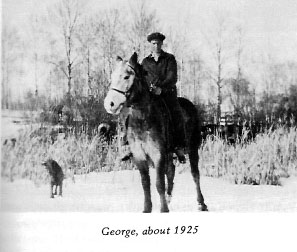
Frank bought a registered red polled bull, named Pilot Whiteswitch. He loaned him to Phil Sillem. Mrs. Sillem was afraid of him and banged the milk pails together to scare him away while she ducked into the barn. Before long he seemed to sense that she was afraid of him and he really became unsafe, but we didn't know this when we brought him home. The first evening at milking time we went to shut him in the corral. He stood his ground, pawing up a cloud of dust. I made a big mistake; I turned my back on him, to pick up a stick, and he landed me one that tossed me up in the air and started to kneel on me when I hit the ground. Frank grabbed a handy 2" x 4" plank and broke it over Eilot's head. We finally got him into the corral. As soon as he could, Frank sold him. He went berserk when they tried to take him away so they blindfolded him to get him to town. He killed himself on the way to Edmonton.
In 1929 I bought the Otto Martin house from Fred Bowtell (paid for it with work), and hired Glen and Gaylord Maxwell to move it with their mules. I soon set up batching. That wasn't much of a life. I still spent my winters in the mine and worked for Frank or Fred Bowtell during summers. It seemed I had very little time to make improvements on my farm. Each fall I worked on various threshing outfits. One fall I remember, Harry Jenner and I slept on our load of bundles. One night it was warm and a grand moonlight evening but the Canada geese were flying south in huge flocks and kept us awake for sometime with their honking. When we woke in the morning we were covered with a heavy blanket of snow.
In 1934, I married Jean Granger, born 1914 on the farm at Laurier Lake. The knot was tied by the Reverend Stolee at the Martin School House. It was a struggle to make ends meet in the thirties. We had terribly dry summers and the dust storms blew over from the south; good Southern Alberta top soil often darkened the sky. We always hoped they were rain clouds, but mostly only a few big drops fell in the dust. That winter, after we were married, and with the help of Joe Delver, an Indian neighbor, who said he was four years old at the time of the Rebellion, I managed to get a fair sized patch of brush cleared. Our farm is bordered on the west by Frog Creek and a range of hills from north to south runs through it. Amy Krider, our neighbor to the south, named it Creek Hills Farm.
In the spring we set up our own "keep physically fit" program, picking rocks and roots off the patch of land I had managed to break while batching. (Our program must have worked as we had very little sickness through the years. I never spent anytime in hospitals until I was past sixty). After seeding was finished we pulled stumps with horses and chain and broke the brushed patch of land with a steel beamed walking plow. I guided the plow, walking between the handles, over rocks and through big willow roots. Jean drove the horses. Then back to picking rocks and roots.
That fall we had an early frost and a granary full of frozen grain worth twenty-five cents a bushel. We had a few pigs and cattle. Cream was worth very little, hardly worth hauling to town, bumping over the road nine miles to Heinsburg in a lumber wagon behind Bess and Snort, but it set the table. I hauled two hundred pound pigs to market and got back two dollars per hog. We received the top price of twelve dollars per head for good two year old steers. Prices improved when the second world war began in 1939. It seemed terrible to us that there had to be a war to end the depression. Pre-war, hard times, and then out of nowhere came all the wealth needed for Canada to fight. By then we had changed from horses to our first tractor.
In 1945 our son, Thomas Edwin, came to live with us and in 1948 Larry George completed our family. By the time the boys were old enough for school the country school had been replaced by a centralized school at Heins- burg and the morning and evening walks, so popular in our day, replaced by busses. The educational system was changing to something called progressive education. It was too "progressive" for my satisfaction as phonics and multiplication tables were being dropped. In spite of being advised otherwise we taught Tom and Larry the sounds and multiplication tables, a move we never regretted.
In 1950 my father passed away in Beverly and Mother and two sisters, Beatrice and Lilian, wanted to come and live at the farm. They bought a house in Heinsburg that Gordon Rainey had built and that Dr. Anne Weigerinck used for a short time as an office. We had Paul Buck move it to the farm. We were a bit skeptical but they liked it here. The next fall we pooled our resources and bought our first car. Mother passed away in 1957 at the age of eighty- six. Beatrice and Lilian remained here until their house burned down in 1971 and they moved to Elk Point. Beatrice still lives there; Lil passed away in January 1975.
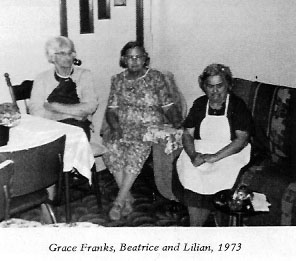
During the 1939-1945 war the newer planes and wonderful jets flew over this area on the way to the recently established Cold Lake Air Base, approximately fifty miles to the north. This had always been a quiet farming district and at first we wondered at the vapor trails and ear-splitting noises that jangled our nerves and frightened the livestock. The jets went over so quickly and were so well camouflaged that our unpractised eye seldom spotted them. Day after day we watched the huge low-flying Box Car that carried men and equipment to the Base. A few years after the war ended we, along with several thousand other Canadians, attended the first air show at Cold Lake and learned that this base had been planned as early as 1915 but the plans were set aside until the second war was imminent and the need became urgent.
We watched the space flights on television during the 1960's and viewed the first landing on the moon. It was almost an eerie experience to realize that this was no make- believe movie, but the real thing. On that day Jean made up this little verse.
Twinkle and beckon, little star
We no longer wonder what you are,
Winking up there your alluring eye
Enticing our boys ever higher to fly.
First they conquered thro' space the moon
But still you beckon and very soon,
Farther and higher they'll fly again
Ever away from this earth's terrain.
Twinkle and beckon, ever afar
How 1 wish you could still be a twinkling star.

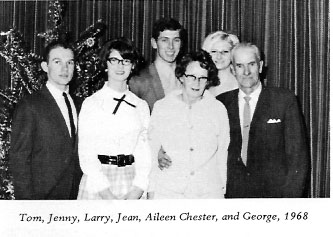
Tom and Larry took their education in Heinsburg through Grade Xl. Tom went to Eastglen School in Edmonton for Grade XII. Larry applied to join the Royal Canadian Air Force, was accepted and given a free trip, his first by jet to Centralia where he was told he could take Grade XII. Centralia, situated in Ontario, was an air base established for the training of Canadian and Australian pilots. (It may have been a Commonwealth base). It was closed shortly before the unification of the Canadian Armed Forces. That year too many recruits applied, who already had completed Grade XII, so Larry was flown back to Edmonton the day before schools opened for the new term. He was fortunate to be allowed to enter Salisbury High School in Sherwood Park; after graduating he worked as a civilian in Edmonton until, in 1967, he was ordered to report for duty and was among the first recruits from Edmonton to join the unified forces. At present he is a captain and flies the noisy, nerve jangling CF104 jets.
Tom has taken over number eight, farming where we left off. He married Virginia, daughter of Gray and Stella Stone of Spring Park. They have three boys; Jason, Colin and Darren. As for us, we are classed with the old timers of the district. We have retired on the farm and are happy here, especially since we now have "city conveniences", telephone, electricity and running water.
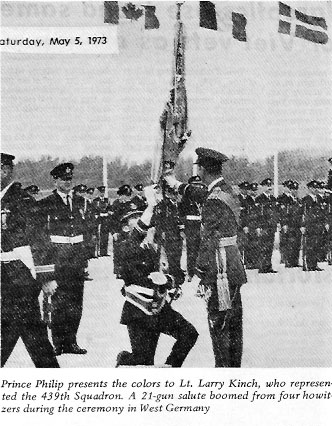
WHERE CARAGANAS GREW --by Jean Kinch
I wandered down a woodland path
The air was fresh and mild,
And found amid tall poplar trees
Caraganas growing wild.
'Tis years since they were planted For they aren't native to this land,
They mark a long deserted home
Built by a pioneer's hand.
Bright bluebells trembled silently
As a gentle breeze swept by, And brought a scent of wild rose
To tempt a butterfly.
Who quickly from a thistle flower Untangled tiny feet,
And fluttered happily away
To find the promised treat.
Above the noise of popping pods
And insect's muted hum,
Within some well secluded spot
I heard a partridge drum.
I lingered till the sunset hues Showed brilliant thro' the trees,
Dusk could not silence popping pods
But hushed the humming bees.
I knew that I should hurry home For dusk began to fall,
And trailing thro' the darkening sky
A night-hawk's peeping call I have not felt such quiet peace
Since I was but a child,
As in that place reserved by God
For caraganas growing wild.
(Added in 1973)
I visited that place today
But grain is waving now,
The popping caragana pods
Were silenced by the plow.
Are hopes and dreams of pioneers
Fulfilled in time's fast pace,
Of travel from the ox and horse
To flights in outer space?


